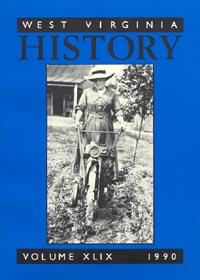

(A copyrighted publication of West Virginia Archives and History)
 |
Preface
By Carol Jean Blum Volume 49 (1990), p. 1 |


 |
Preface
By Carol Jean Blum Volume 49 (1990), p. 1 |
The art of telling a story has a long and rich tradition in West Virginia. These stories and tales serve a critical function in preserving and shaping the community's and state's sense of history. Events or people are described, sometimes enlarged, to remind the listeners of its importance, highlight its unusual character, or simply not lose the memory of the event or person.
The job of a historian is to tell a story, with as little exaggeration as possible, and place it within the larger history of the state, nation or the world. The historian's and the story teller's tasks are the same, diverging in method and presentation but alike in their intent to preserve the past. This issue of West Virginia History presents the story of West Virginia women's role in the development of the state from a variety of perspectives.
The subjects chosen for study in this volume attempt to link the apparently disparate but very familiar aspects of women's lives, their paid and unpaid work in their homes and communities, into a unified image. The articles, read together, present persuasive evidence that women's work and activities made a solid foundation upon which the state's economy was built. Whether working on a family farm, in a coalfield community, urban factories, or schoolrooms throughout the state, women have maintained their families in good times and bad. Their volunteer activities in organizations and less-formal networks built a social infrastructure from which communities grew and prospered. The authors explored these themes in different settings, using a variety of evidence, manuscripts, published reports and interviews. Their work adds to a growing body of research on women and should encourage further investigations into the story of women in West Virginia. These articles are a part of a multi-year project of re-discovery and reconsideration of the history of West Virginia's women, which was organized by the West Virginia Women's Commission. This volume represents just one way of sharing the fruits of the research by these women and many others, including archivists, librarians, and community members from throughout the state. A traveling exhibition of three distinct parts will be hosted by the state's public and community libraries from 1990 to 1992, and a larger museum exhibition is being prepared for presentation in Charleston, Huntington, Wheeling, Parkersburg and other selected locations.
Under the leadership of the West Virginia Women's Commission and the West Virginia Women's Foundation, a statewide, forty-six member planning committee has met since 1986 to plan the activities briefly outlined above. Generous awards from the Humanities Foundation of West Virginia and the National Endowment for the Humanities' Libraries Division provided support for the ten scholars whose work is presented here. This special issue of West Virginia History benefited from the advice and cooperation of the journal's Editorial Advisory Board and staff and the West Virginia Division of Culture and History. The authors also received invaluable assistance in the review of the articles in various phases of preparation from Dr. Barbara Melosh whose essay introduces this volume. The scholars and the planning committee were ably served in the preparation of this volume by Women's Commission and project staff members Debra Parson, Barbara Reed and Carolyn Mallory. Finally, the leadership of Barbara Matz and Nancy Matthews kept the vision clear and attainable. This issue of West Virginia History and the exhibitions and related programs are dedicated to the women of West Virginia who preceded us and those who follow.